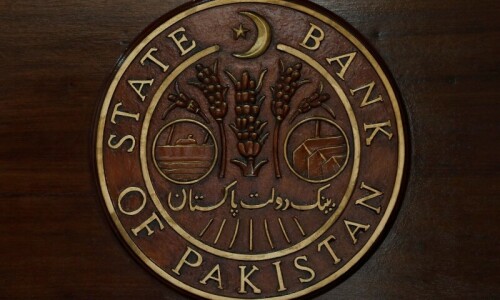
LAHORE: An exhibition of artworks featuring works of 11 artists, titled ‘Tomorrow Isn’t Promised’, a collateral event of the Lahore Biennale 03, is attracting visual art lovers in good numbers at the 11 Temple Road. The exhibition will remain on display till Nov 7.
The exhibition aims at taking a multi-faceted view of our environmental histories through art, design and research-based practices with a continuing discourse on the environment and its elements of water, air and land. It offers insights into several personal journeys and trajectories and how they might offer lessons of resilience and course correction. The exhibition features works of 11 artists, namely Affan Baghpati, Ameer Hamza, Marjan Baniasadi, Nabiha Khan, Rahma S Kareem, Saba Qizilbash, Sidra Khwaja, Talha Shams and Zeb Bilal.
According to Fatima Shah, the curator, looking back is sometimes seen as purely romanticised nostalgia but it is a way of being, wishful thinking as well as unrealised dreams of what has been with consequences for what might be. In some form or the other, the interplay of humans and their interaction with the ecosystem has been tried and tested to give us our present.
Ms Shah says a beautiful reminder of this is Bagh-e Hind, an online exhibition curated by Bharati Lalwani and Nicolas Roth, as a multisensory experience which (re)creates and constructs ‘scent-scapes’ as a world of beauty that may be displayed, quantified and even measured, while remaining invisible. Conceptualised around the olfactory landscapes of 17th and 18th century Mughal-era South Asian paintings, it seeks to take viewers on a journey through historic gardens of opulence, abundance and beauty by reuniting the sensual, botanical, musical and intellectual culture of the time.
“We are proud to bring a part of Bagh-e Hind–specifically the chapter on smoke--to Lahore, in the exhibition’s third iteration in a physical space,” the curator said.
According to Fatima Shah, the works of Maryam Baniasadi who is consistently altering the scale of trees and flowers offers us reminders to refocus our attention. Through his works, Ameer Hamza paints long forgotten wars as pages of a historical manuscript, yet to be written. Each scene can be imagined as a pre-cursor or an aftermath of the human design to conquer geography, at times with harsh consequences and at immense costs. There is a palpable tension on the surface of his works where gestural marks and several washes allude to the painstaking process. Hamza challenges the status quo and holds the spotlight on intricate details of significant historic events and their enduring dangerous legacy.
The Chillum-e-Bukhoor installation by Nabiha and Zeb in the main courtyard, designed as a series of freestanding structures provides both a visual and an olfactory experience. The chillum (hookah) is symbolic of shared bonds and storytelling whether in the rural countryside or in urban settings, which eventually became a symbol of colonial hybridity. The installation reimagines the form as a crucible of spicy fragrance to evoke memories of place and social practice. Just as scent has been used to create auras, smell has also been weaponised for crowd control and the power of this medium to transgress boundaries and borders has been demonstrated in ongoing wars and in fighting protests for peace.
The works of Saba Qizilbash and Sidra Khawaja both illustrate contentious history and geography as a consequence of the ‘unfinished business’ of the partition of India in 1947.
Saba’s large-scale drawing is a reminder of the unstable and unsustainable tumult at the Line of Control (LoC) where she presents a site of the ongoing tug-of-war for land, its natural resources and the challenges it poses for the communities living in one of the harshest climatic regions in the world.
Published in Dawn, October 8th, 2024












































